What is PromKappa ?
PromKappa is an interesting program designed late last year (2012) that aims at analyzing the promoters of genes by using a Second World War cryptographic method. The source of PromKappa program is written in Visual Basic 6.0. The source code has not yet been ported to other programming languages.
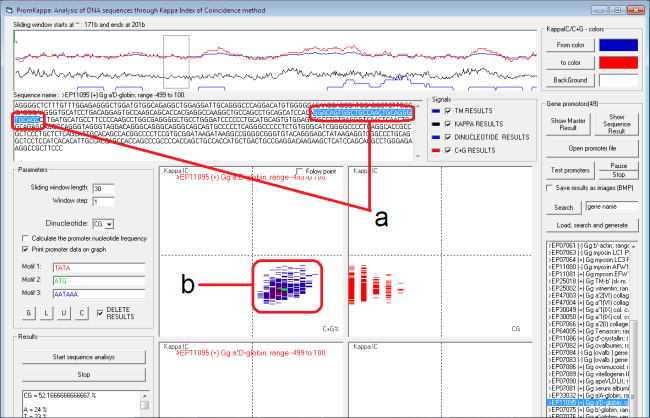
Relationship between the shape of the promoter pattern and different structures such as Simple Sequence Repeats (SSRs) or short tandem repeats (STRs). (a) the sliding window, (b) green line in the middle of the pattern reflects the sliding window position and the local characteristics of the promoter sequence.
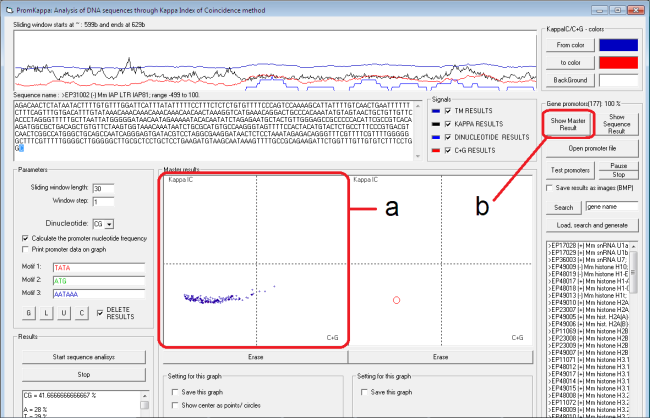
Distribution of promoters in Mus Musculus. (a) each circle represents the center of weight from a promoter pattern, (b) on click, the button is showing the promoter pattern distribution Tab.
In the figure below some images are shown, containing impressions (DNA patterns) generated from the same DNA molecule variant from several species (each image represents a DNA sequence of 500 characters).
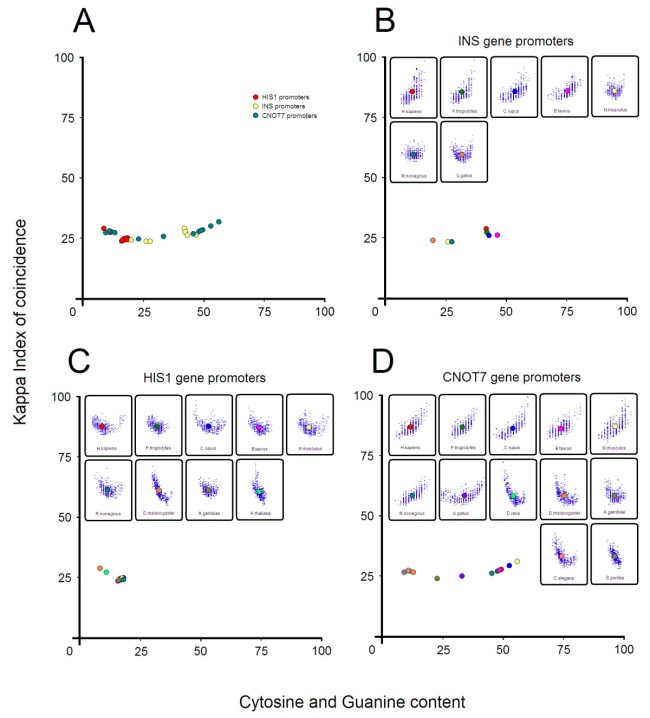
General purpose of PromKappa
The input of the program is a text (a DNA sequence), the output is an image, an image specific for that DNA sequence. PromKappa is designed to read (one by one) short DNA sequences (between 30 and 10,000 bases) from a single FASTA file and to generate an image for each DNA sequence. In each analysis, the images generated are automatically saved in BMP format (at user request) in the “chart” directory.
The analysis of a single DNA sequence can be also done manually (copy / paste). The shapes from the images are also called patterns or DNA patterns. What scientists have observed, is that these images have a stunning logic when they are ordered.
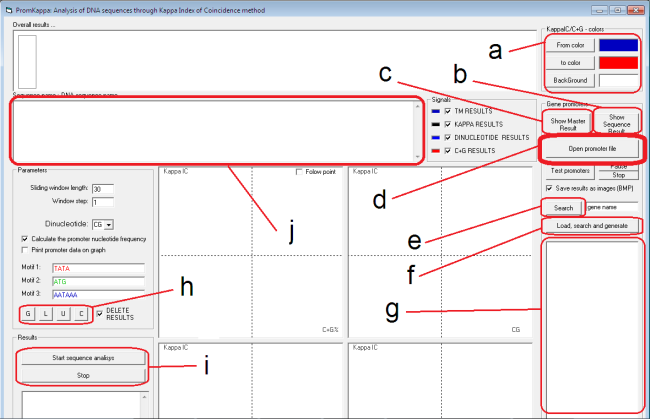
PromKappa manual analysis. (a) background and pattern color, (b) promoter pattern Tab, (c) promoter pattern distribution Tab (d) file loading, (e) gene name search, (f) automatic searching of gene names in the promoter list, (g) promoter sequence container, (i) manual analysis of a single promoter sequence, (h) buttons for promoter sequence editing (G-random sequence generation, L-lowercase U-uppercase, C-sequence filtering of carriage return (CR) and line feed (LF) characters), (j) text box containing the promoter sequence for immediate analysis.
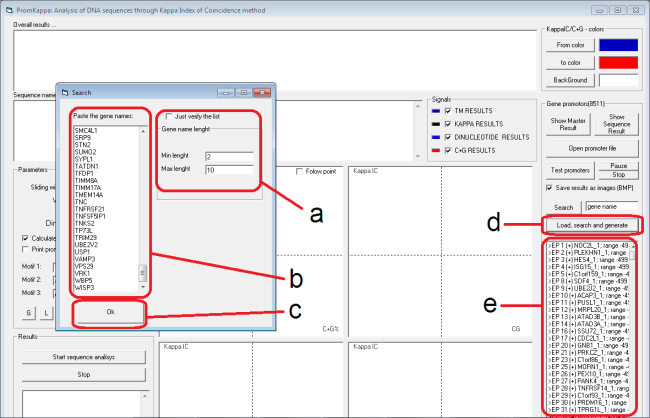
PromKappa automatic search of promoters by using lists of gene names. (a) minimum and maximum number of characters for the gene name, (b) list of gene names, (c) the button that starts the search process, (d) the button that opens the search window, (e) promoter sequence container.
How to analyze PromKappa images ?
In order to analyze PromKappa images a second program must be used, called PromNN. PromNN is a neural network which is capable to recognize forms on images. The purpose of this program is to learn the forms from these images and to recognize them later. eg PromNN can be taught to recognize 10 different image forms. After that, it can categorize an infinite (theoretical) number of such images. In order to be analyzed by PromNN, the images generated by PromKappa (from the “chart” directory) must be converted to JPG format and stored in the same folder.
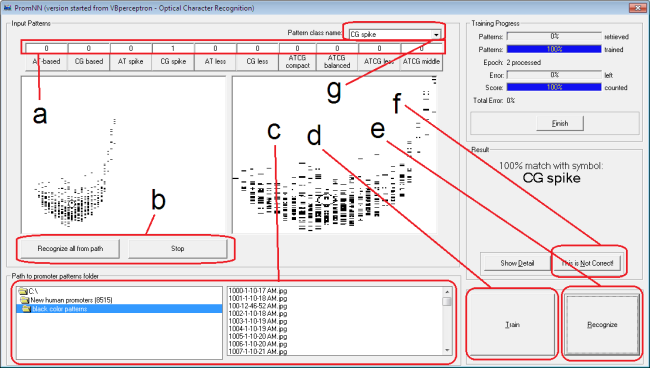
PromNN. (a) the number of promoters found for each class, (b) automatic recognition of all promoter patterns contained in a folder, (c) path navigation to the folder containing the promoter patterns generated by PromKappa (d) neural network pattern learning, (e) neural network recognition verification, (f) neural network reinforcement of pattern recognition in case of error, (g) promoter class name.
At what has been used ?
Until recently, the issue of promoters in eukaryotes has been truly foggy. So, the problem in question was that of gene promoters (ie how many promoters are out there in eukaryotes and what are their characteristics)
Where it can be downloaded ?
Download from here
PromKappa errors
On certain computers, PromKappa in its original form gives an error: “Run-time error 6: Overflow”
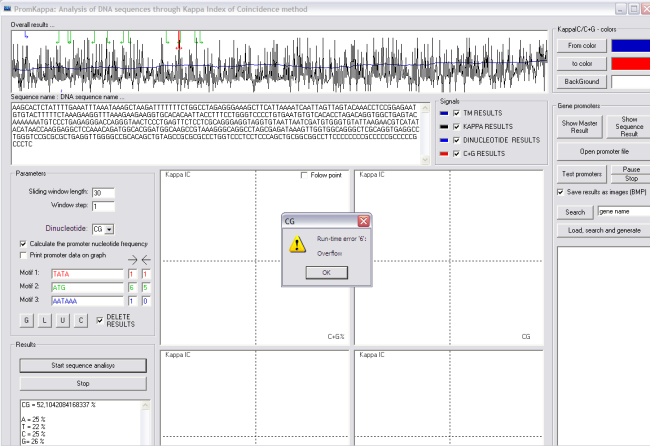
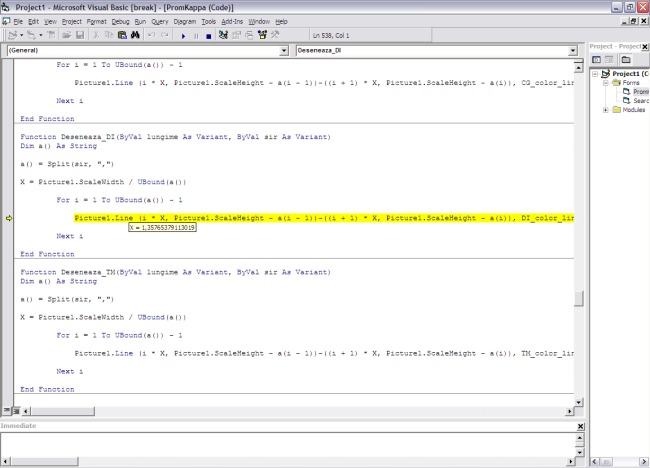
The solution is to run PromKappa on Windows 7 or to install Visual Basic 6.0 on your computer.
Sources:
http://www.biomedcentral.com/1471-2164/13/512
http://www.biomedcentral.com/1471-2164/13/512/additional
Tags: bioinformatics, eukaryotes, gene promoters, genetics, PromKappa, promoters of genes, visual Basic 6









Recent Comments